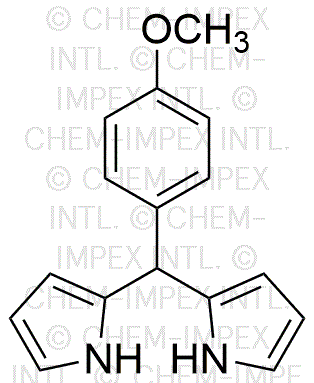5-(4-Methoxyphenyl)dipyrrylmethane is widely utilized in research focused on:
- Fluorescent Probes: This compound is used in the development of fluorescent sensors for detecting metal ions, which is crucial in environmental monitoring and biomedical applications.
- Organic Photovoltaics: It plays a significant role in organic solar cells, enhancing energy conversion efficiency due to its unique electronic properties.
- Medicinal Chemistry: Researchers explore its potential as a therapeutic agent, particularly in targeting specific biological pathways, which may lead to new treatments for various diseases.
- Material Science: The compound is investigated for its use in creating advanced materials with tailored optical and electronic properties, beneficial for electronics and nanotechnology.
- Biological Imaging: Its application in imaging techniques allows for better visualization of biological processes, aiding in research and diagnostics in life sciences.
General Information
Properties
Safety and Regulations
Applications
5-(4-Methoxyphenyl)dipyrrylmethane is widely utilized in research focused on:
- Fluorescent Probes: This compound is used in the development of fluorescent sensors for detecting metal ions, which is crucial in environmental monitoring and biomedical applications.
- Organic Photovoltaics: It plays a significant role in organic solar cells, enhancing energy conversion efficiency due to its unique electronic properties.
- Medicinal Chemistry: Researchers explore its potential as a therapeutic agent, particularly in targeting specific biological pathways, which may lead to new treatments for various diseases.
- Material Science: The compound is investigated for its use in creating advanced materials with tailored optical and electronic properties, beneficial for electronics and nanotechnology.
- Biological Imaging: Its application in imaging techniques allows for better visualization of biological processes, aiding in research and diagnostics in life sciences.
Documents
Safety Data Sheets (SDS)
The SDS provides comprehensive safety information on handling, storage, and disposal of the product.
Product Specification (PS)
The PS provides a comprehensive breakdown of the product’s properties, including chemical composition, physical state, purity, and storage requirements. It also details acceptable quality ranges and the product's intended applications.
Certificates of Analysis (COA)
Search for Certificates of Analysis (COA) by entering the products Lot Number. Lot and Batch Numbers can be found on a product’s label following the words ‘Lot’ or ‘Batch’.
*Catalog Number
*Lot Number
Certificates Of Origin (COO)
This COO confirms the country where the product was manufactured, and also details the materials and components used in it and whether it is derived from natural, synthetic, or other specific sources. This certificate may be required for customs, trade, and regulatory compliance.
*Catalog Number
*Lot Number
Safety Data Sheets (SDS)
The SDS provides comprehensive safety information on handling, storage, and disposal of the product.
DownloadProduct Specification (PS)
The PS provides a comprehensive breakdown of the product’s properties, including chemical composition, physical state, purity, and storage requirements. It also details acceptable quality ranges and the product's intended applications.
DownloadCertificates of Analysis (COA)
Search for Certificates of Analysis (COA) by entering the products Lot Number. Lot and Batch Numbers can be found on a product’s label following the words ‘Lot’ or ‘Batch’.
*Catalog Number
*Lot Number
Certificates Of Origin (COO)
This COO confirms the country where the product was manufactured, and also details the materials and components used in it and whether it is derived from natural, synthetic, or other specific sources. This certificate may be required for customs, trade, and regulatory compliance.


